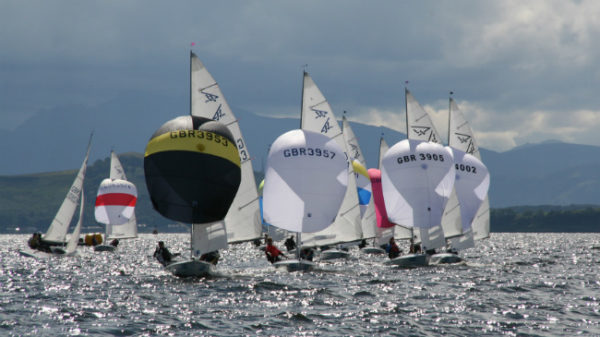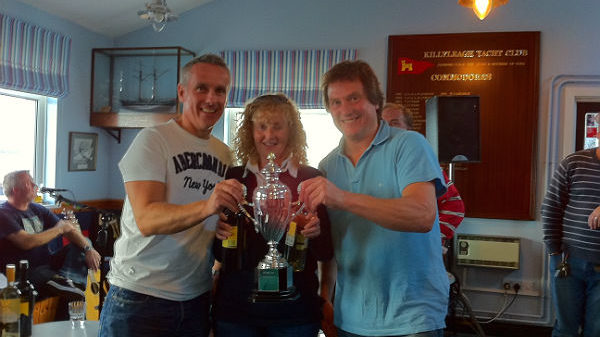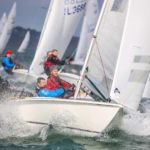By Hook or by crook… Ahead of the South Coast Championship in Dunmore East in July, local Dinghy Class Captain Charlie Boland charts the ongoing renaissance of the Fifteens, and outlines the appeal of this special sailing location
If you are planning a trip to Dunmore East this summer you will be glad to read that Waterford Estuary boasts ideal sailing conditions. The open waters are unaffected by extreme tides or currents and, while the local coastline may lack the drama of Ireland’s west coast, the low profile landscape means that winds are steady and sailing fair.
Racing can take place as near as 5 minutes from the slipway, so there will no long sails to or from the race area, meaning that we can get back all the sooner for that well deserved first pint!
Because most Flying Fifteen sailing on this island takes place in the relatively flat waters of Strangford Lough and Dublin Bay, a visit to Dunmore East on the south east coast brings to mind one thing in particular… waves! When the breeze comes up you can expect the full effect of the Atlantic swell.
Flying Fifteens are made for these open waters. The highlight of my own first Flying Fifteen event here several years back was an unforgettable screaming reach during the final race. I was hooked.
Flying Fifteens have been sailed in these parts since the 1970’s. The local seabed has been home to several of them since the days when they were raced out around Hook Head to Fethard on Sea for a bottle of Haig whiskey. No dry suits back then!
These days, we stick to the safety of the bay and thankfully the modern hulls handle the swell somewhat better than those earlier designs.
 The Venue
The Venue
Founded in 1934, Waterford Harbour Sailing Club is a welcoming, family-based club with over 200 members. WHSC has a strong volunteer base and a proud history of hosting visiting fleets, running at least two regional / national events each year. A newly extended slipway opened in 2014, which has made launching swift and hassle-free.
Incoming commodore Ronan Mulligan explains the club’s appeal: “WHSC has now firmly established itself as one of the most sought after locations for sailing events in Ireland, due to a committed membership keen to stage major regattas. Great sailing conditions and the recent doubling in size of the slipway adjacent to the clubhouse now allows us to deliver a really special event.
“Once off the water, competitors can enjoy a pint in our superbly appointed clubhouse overlooking the estuary or simply take a stroll and enjoy the craic in one of the most beautiful villages in Ireland.
“We are really looking forward to hosting a large fleet of Flying Fifteen sailors and their families this summer. The guys have been working really hard to rebuild the class here at the club and the Committee and I want to support that drive in any way that we can.”
 The Village
The Village
Dunmore East has something for everyone. Visitors to the village can enjoy great food, hospitality and an extensive choice of accommodation. The local tourist group’s website describes it as “a little gem of a fishing village perched on the cliff edge”. A sign on the door of Power’s pub labels it “a drinking village with a fishing problem”… I guess it depends on who you’re asking! Like I said, Dunmore East has something for everyone.
Local Renaissance
While the Flying Fifteen has long been synonymous with these parts, the local fleet almost completely disappeared a few years back. Throughout the 1990’s as many as seventeen boats participated in racing at WHSC.
However, when the more competitive sailors upgraded to the Ovington Mark 9 in the late 90’s, the local fleet fell into decline as older hulls could no longer keep pace and their owners, no longer able to anti-foul and moor, lost heart. By 2008 only one boat remained.
Lately something of a local renaissance is taking place, thanks to the efforts of a group of enthusiastic members. In an attempt to revive the fleet we unearthed (literally in some cases) a number of classics from gardens and sheds locally.
The fleet number initially rose from one to five, with three classics and two Ovvies in the dinghy park. It was enough for us to say that a class existed again and to launch a campaign to promote the fleet further.
 In October we held an information meeting which just under thirty sailors attended. This led to the purchase of four more boats (two classics and two Ovvies). So we begin the season with nine and with a bit of luck we will break double figures.
In October we held an information meeting which just under thirty sailors attended. This led to the purchase of four more boats (two classics and two Ovvies). So we begin the season with nine and with a bit of luck we will break double figures.
Therefore it really is with great pleasure that we welcome the fleet this summer, as it will be very satisfying to see a result sheet with potentially as many as nine WHSC entries included.
At a time when the Irish Sailing Association has been forced to address the general decline in dinghy sailing in Ireland, perhaps our story contains some lessons. While we were keen to see some new boats come into the club, in the economic climate which we found ourselves in there was little prospect of that happening. We could never have redeveloped the gold fleet without first developing a classic fleet for beginners to buy into.
Now that there are nine masts lined out in the dinghy park, we have aroused some interest and we are in a better position to attract more competitive sailors, as well as providing an entry point to the sport. This year we will provide free coaching to new sailors in an attempt to bring them on.
Lesson learned: We need to support those at the bottom as the top tends to look after itself.
By Hook or by crook
Across the bay from Dunmore East stands Hook Lighthouse (pictured above), the oldest operational lighthouse in the world. The existing tower dates from the twelfth century, although missionary monks are thought to have established a beacon on the spot as far back as the fifth century.
Local tradition has it that the phrase “By hook or by crook” comes from the names of Hook Head, upon which the lighthouse stands, and the village of Crooke on the Waterford side of the harbour. Oliver Cromwell is reputed to have coined the phrase whilst plotting his approach during the invasion of 1649. Cromwell decided that Waterford would be taken ‘by Hooke or by Crooke’, that is, by a landing of his army at one of those two places.
When trying to get our heads around which way to go up that first beat on July 4th, we might all relate to Cromwell’s dilemma (if not his confidence).
Nothing like history to put our problems into perspective!
See you in July…
- This article originally appeared in FF World magazine




